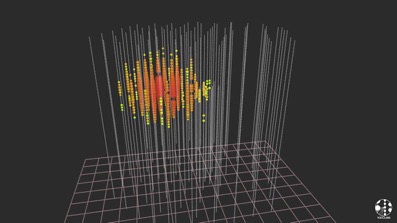Neutrino Physics and Astrophysics
with IceCube



A PeV neutrino
in IceCube


DeepCore
IceCube

AMANDA

Phys. Rev D91, 072004 (2015), Neutrino 2016
My primary research focus is IceCube, a
neutrino telescope at the South Pole. Neutrinos
are elementary particles, one of the basic
building blocks of the universe, but they’re
difficult to study because they don’t often
interact with other matter. To see a reasonable
number of them, we need to build a huge
detector, so we have sunk about 5,000
photodetectors into the Antarctic ice cap.
These photodetectors, which we call Digital
Optical Modules (DOMs), are deployed in a three-dimensional array about a mile below the surface of the ice. They monitor a cubic kilometer of ice (about 1 billion tons!), looking for flashes of light produced when a neutrino interacts with the ice. A project of this scale requires the collaborative efforts of several hundred physicists, known as the IceCube Collaboration. I am presently the Deputy Spokesperson of the collaboration.
We can’t see neutrinos themselves as they pass through our detector, but when they interact they produce other particles, like electrons or their heavier cousins muons and taus, and those particles will give off light known as Cherenkov radiation that we can see. By comparing the times at which different DOMs see the light, we can reconstruct the trajectory of the particles passing through the array.
We can learn several things from these neutrinos. The main goal is to point back along the tracks of the neutrinos to see where they’re coming from. We expect that neutrinos will be produced wherever the cosmic rays are accelerated, perhaps near a supermassive black hole or in the death of a massive star, and so detecting a stream of neutrinos coming from a particular object in the universe would be very good evidence telling us about the sources of the cosmic rays. The number and energy spectrum of the neutrinos would tell us about the dynamics of the matter and energy in the source, as well. We have detected several dozen neutrinos produced in sources outside our Solar System, including the one shown at the top of this page, and are working hard to try to understand where they come from.
Neutrinos can be produced in other ways besides as by-products of cosmic ray acceleration. We believe that dark matter makes up a large part of the mass of the universe – a much larger part than all of the stars and galaxies and everything else we can see – although we don’t know what it is. Some of this dark matter has probably been pulled into the Sun by gravity, although it wouldn’t interact much with the hydrogen and helium and so forth in the Sun. Particles of this dark matter may annihilate each other from time to time, which could produce neutrinos that IceCube might detect. An extension of IceCube, called DeepCore, was originally designed to lower the energy threshold of IceCube enough to detect such neutrinos. DeepCore began taking data in June 2010, and the analysis of this data has been my focus for the last few years. I was one of the original leaders of IceCube’s DeepCore working group, and later of the Neutrino Oscillations working group.
We can study the fundamental properties of neutrinos with DeepCore data, as well as searching for dark matter. Neutrinos are produced in large numbers in our atmosphere when cosmic rays hit the Earth, so we will detect millions of neutrinos over the lifetime of IceCube. We use these neutrinos to study how they oscillate between flavor states. We believe it would also be possible to learn about the hierarchy of the masses of different types of neutrinos this way, although doing so would probably require a further extension of IceCube DeepCore, known as PINGU (the Precision IceCube Next Generation Upgrade). Most importantly, because IceCube makes these measurements at much higher energies than other experiments, we can look for unexpected new neutrino physics by comparing our measurements to those made in different ways at different energies.
More information about IceCube is available at the official IceCube web site at the University of Wisconsin. My work on IceCube is supported by Michigan State University.

